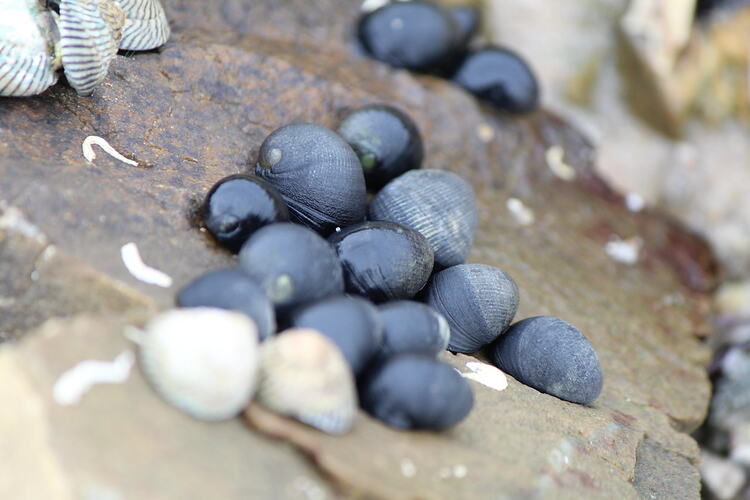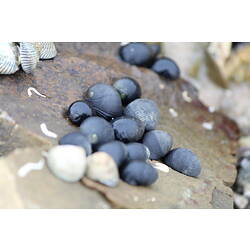General Description
Black shell. Flattened spire with expanded final whorl (body whorl). Shell mostly smooth but has very fine, almost indistinguishable, spiral lines, usually 15-22. Large, semicircular aperture with cream inner lip. Operculum (shelly flap covering the shell aperture) orange-tan with irregular black stripes. Shell up to 3 cm long. Can be difficult to distinguish from Nerita atramentosa, which is externally very similar. The most obvious difference is the different colour and shape of the opercula and the colour of the inner lip. Can be difficult to distinguish from Nerita atramentosa which is externally very similar. The most obvious difference is the different colour and shape opercula and the colour of the inner lip.
Biology
There are two species of Black Nerite in Australia, but until recently only one was recognised. Prior to 2007, all Black Nerites were called Nerita atramentosa, which ranged from Western Australia to Queensland. Now it is recognised that some individuals previously called N. atramentosa are N. melanotragus, a name previously only used in New Zealand. The two species look very similar, but can be distinguished by the colour of their operculum. N. melanotragus has a more easterly range from Queensland to South Australia while N. atramentosa occurs more to the west from Western Australia to New South Wales. There is a definite crossover in the ranges of the two species with a break occurring around Wilson's Promontory in Victoria; in this zone of overlap N. melanotragus is more common to the east and N. atramentosa is more common to the west. Most museum specimens have not yet been re-identified to see which are really N. melanotragus. The biology of the two species appears to be very similar. They live around 3 years and both reproduce via internal fertilisation. Egg capsules are laid by the females on the underside of rocks and the larvae hatch from them and join the plankton before settling and metamorphosing some time later. Both species are grazers, feeding on microalgae films covering rocks.
Distribution
Northern New Zealand and Kermadec Islands. Southern mainland Australia and Tasmania, Norfolk and Lord Howe Islands.
Habitat
Mid to high intertidal areas of rocky shores.
More Information
-
Animal Type
-
Animal SubType
-
Brief Id
Round black shell, orange-tan operculum.
-
Colours
Black, Brown
-
Maximum Size
3 cm
-
Habitats
-
Diet
Herbivore
-
Diet Categories
Algae
-
Endemicity
-
Commercial
No
-
Conservation Statuses
CITES: Not listed, FFG Threatened List: Not listed, DSE Advisory List: Not listed, IUCN Red List: Not listed
-
Depths
Shore (0-1 m)
-
Water Column Locations
On or near seafloor
-
Taxon Name
-
Scientific Author
Smith, 1884
-
Common Name
Black Nerite
-
Phylum
-
Subphylum
-
Superclass
-
Class
-
Subclass
-
Superorder
-
Order
-
Suborder
-
Superfamily
-
Family
-
Subfamily
-
Genus
-
Subgenus
-
Species Name
melanotragus


